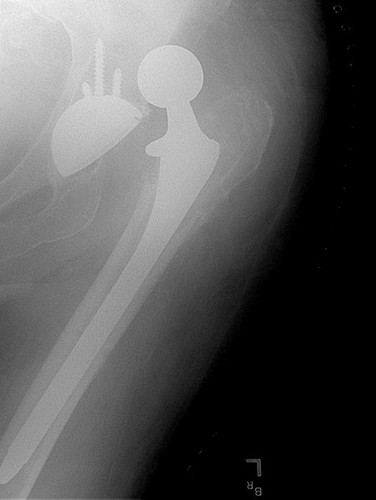Complications of Total Hip Replacement
As with all major surgical procedures, complications can occur. The most common complications following hip replacement are:
- Thrombophlebitis
- Infection in the joint
- Dislocation of the joint (anatomy of the hip)
- Loosening of the joint
This is not intended to be a complete list of the possible complications, but these are the most common. Pneumonia can also result from anesthesia if you don’t do breathing exercises after surgery. Here are more tips on recovery after surgery.
Thrombophlebitis
Thrombophlebitis, sometimes called Deep Venous Thrombosis (DVT), can occur after any operation. It is more likely to occur following surgery on the hip, pelvis, or knee. DVT occurs when the blood in the large veins of the leg forms blood clots within the veins. This may cause the leg to swell and become warm to the touch and painful. If the blood clots in the veins break apart they can travel to the lung. Once in the lung they get lodged in the capillaries of the lung and cut off the blood supply to a portion of the lung. This is called a pulmonary embolism. Pulmonary means “lung”. An embolism is a fragment of something traveling through the vascular system (blood vessels). Most surgeons take preventing DVT very seriously. There are many ways to reduce the risk of DVT, but probably the most effective is getting you moving around as soon as possible!
Some of the commonly used preventative measures include:
- Pressure stockings to keep the blood in the legs moving.
- Medications that thin the blood and prevent blood clots from forming.
- Pedaling your feet while lying down, both in the hospital and when you get home.
- Getting up and waking around at least once an hour.
Infection
Infection can be a very serious complication following an artificial joint replacement. The chance of getting an infection following total hip replacement is probably around 1 in 100 total hip replacements. Some infections may show up very early – before you leave the hospital. Others may not show up for months, or even years, after the operation.
Also, an infection can spread into the artificial joint from other infected areas. Your surgeon may want to make sure that you take antibiotics when you have dental work, or surgical procedures on your bladder or colon to reduce the risk of spreading germs to your new joint. Once you get home, take your temperature twice a day to check for a fever and call your surgeon if it gets above 100.5 F degrees.
Dislocation

Just like your real hip, an artificial hip can dislocate. Dislocation is when the ball comes out of the socket. There is a greater risk of dislocation right after surgery, before the muscles and tendons around the new joint have healed. However, there is always a risk of dislocation.
The physical therapist will carefully instruct you on hip precautions—how to avoid activities and positions which increase the risk of hip dislocation. A hip that dislocates more than once may have to be revised, which means another operation, to make the joint more stable.
Loosening
The major reason that artificial joints eventually fail continues to be loosening of the joint where the metal or cement meets the bone. There have been great advances in extending the life of an artificial joint. Still, most joints will eventually loosen and require a revision.
Hopefully, you can expect 12-15 years of service from your artificial hip. In some cases the hip will loosen earlier than that. Just like your diseased hip, a loose joint causes pain. Once the pain becomes unbearable, another operation will probably be required to replace the hip.
More Articles About Hip Replacement
The information presented here—in timeline order—can help you learn what to expect when having a hip replacement from planning through recovery.
- Total Hip Replacement: a guide for surgery and recovery
- Your Visit with the Orthopedic Surgeon
- Minimally Invasive Hip Replacement
- Making Arrangements for Hip Replacement Surgery
- Pre-surgery planning and timeline
- Getting Ready for Hip Replacement Surgery
- The Hip Replacement Operation
- Complications of Hip Replacement Surgery
- On the Road to Recovery After Hip Replacement
- Hip Precautions After Hip Replacement